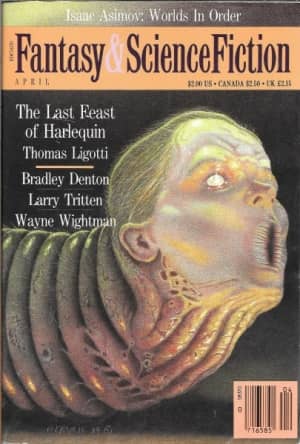Birthday Reviews: Thomas Ligotti’s “The Last Feast of Harlequin”

Thomas Ligotti was born on July 9, 1953.
Ligotti’s collection The Nightmare Factory won the British Fantasy Award and the Bram Stoker Award. He won additional Bram Stoker Awards for his novelette “The Red Tower” and his story “My Work Is Not Yet Done.” The latter work also earned Ligotti his first International Horror Guild Award. He won a second IHG for The Nightmare Factory. A translation of his collection Grimscribe: His Lives and Works won the Italia Award for International Novel.
“The Last Feast of Harlequin” was originally published in the April 1990 issue of The Magazine of Fantasy and Science Fiction, edited by Edward L. Ferman. Terri Windling and Ellen Datlow picked it up for the fourth annual edition of The Year’s Best Fantasy and Horror and Stephen Jones and Ramsey Campbell picked it for Best New Horror 2. Ligotti included the story in his collections Grimscribe: His Lives and Works. The Nightmare Factory, The Shadow at the Bottom of the World, and Songs of a Dead Dreamer and Grimscribe. Ferman and Kristine Kathryn Rusch used the story in The Best from Fantasy & Science Fiction: A 45th Anniversary Anthology. Jim Turner selected it for Cthulhu 2000: A Lovecraftian Anthology and Scott David Aniolowski selected it for Return to Lovecraft Country. Joyce Carol Oates used it in American Gothic Tales and Peter Straub included it in American Fantastic Tales: Terror and the Uncanny from the 1940s to Now. S.T. Joshi used the story in the anthology A Mountain Walked. The story has been translated into German twice as well as Italian and Finnish. It was nominated for the World Fantasy Award for Best Short Story.
Ligotti presents the research of an anthropologist into clowns in folk culture in “The Last Feast of Harlequin.” An anonymous source sends the professor a note about a strange festival in the town of Mirocaw that features people dressing as clowns. Unable to learn anything about the festival through normal sources, including exchanging letters with the state’s Department of Tourism, the professor forgets about the festival until chance brings him to the town and he learns that the festival is held during the Winter solstice, bringing it in conflict with the more traditional Christmas celebrations.
Returning for the actual festival, with very little knowledge of what to expect, the anthropologist tries to learn from the townfolk why they do what they do, only to find that every avenue of inquiry is a dead end. The villagers don’t know why they have the traditions, they just know that they follow them. In the process, he does realize that one of his old professors is living there, apparently a derelict in a part of the town, which at first doesn’t appear to participate in the festival, but later he learns does with different rules.
The story opens with a detailed description of the area in which Mirocaw is locate, identifying the town as secluded and with its own customs, cut off from the rest of the Midwestern state in which it is located, but with strong ties to its New England origins. Despite not being horrific in any way, this sort of descriptions is reminiscent of many Lovecraftian stories and therefore sets up the eventual denouement, a subtle foreshadowing that makes the reader feel like they are watching the anthropologist’s actions while wanting to shout “don’t do that!”
The narrator does reveal some of his conclusions, or at least suppositions about the festival in Mirocaw throughout the story, but it isn’t clear how much they are based on his actual observations or are projections of what he wants the situation to be. Ligotti hasn’t given enough information about the narrator for the reader to determine how reliable the narrator is, nor how good an anthropologist he is, although indications are not in the narrator’s favor for either point.
Reprint reviewed in the anthology The Year’s Best Fantasy and Horror: Fourth Annual Collection, edited by Ellen Datlow and Terri Windling, St. Martin’s Press 1991.
 Steven H Silver is a sixteen-time Hugo Award nominee and was the publisher of the Hugo-nominated fanzine Argentus as well as the editor and publisher of ISFiC Press for 8 years. He has also edited books for DAW and NESFA Press. He began publishing short fiction in 2008 and his most recently published story is “Doing Business at Hodputt’s Emporium” in Galaxy’s Edge. Steven has chaired the first Midwest Construction, Windycon three times, and the SFWA Nebula Conference 6 times, as well as serving as the Event Coordinator for SFWA. He was programming chair for Chicon 2000 and Vice Chair of Chicon 7. He has been the news editor for SF Site since 2002.
Steven H Silver is a sixteen-time Hugo Award nominee and was the publisher of the Hugo-nominated fanzine Argentus as well as the editor and publisher of ISFiC Press for 8 years. He has also edited books for DAW and NESFA Press. He began publishing short fiction in 2008 and his most recently published story is “Doing Business at Hodputt’s Emporium” in Galaxy’s Edge. Steven has chaired the first Midwest Construction, Windycon three times, and the SFWA Nebula Conference 6 times, as well as serving as the Event Coordinator for SFWA. He was programming chair for Chicon 2000 and Vice Chair of Chicon 7. He has been the news editor for SF Site since 2002.